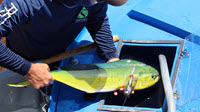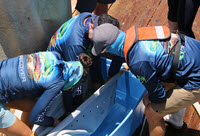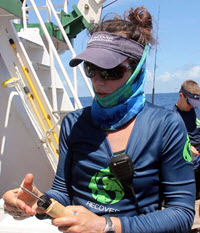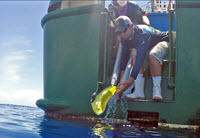
A mahi is loaded into a recovery tank after tagging. (Provided by RECOVER)
Data and pictures from before and after a disaster help us understand the impacts of an event; however, the “before” is not always available. Researchers with the Relationships of Effects of Cardiac Outcomes in fish for Validation of Ecological Risk (RECOVER) consortium have found through oil-exposure laboratory studies that the Deepwater Horizon incident may have negatively affected mahi-mahi’s heart function, vision, and swim performance. To get the “before” data on mahi-mahi behavior, the researchers are using data-collecting tags to explore how the fish behave in the wild under typical conditions for comparison studies.

Researchers work together to lower a mahi into an oxygenated bin that will help keep the fish healthy during the tagging process. (Provided by RECOVER)
During a recent expedition, researchers aboard the R/V Walton Smith used a new tag-and-release strategy for mahi-mahi. Tagged fish were held in 1,320-gallon tanks for 24 hours, allowing the fish to recover from angling and handling stress. Because tags used in previous expeditions have not stayed with the fish longer than 10 days, the team hypothesized that the increased recovery time before release would improve tag retention and fish survivability. The most recent feedback proved this hypothesis to be correct as tag retention more than doubled. The pop-up satellite archival tags that the researchers are using collect acceleration information (which helps determine if the fish is spawning) as well as water temperature, depth, and migration data. The team hopes to collect up to 96 days of data using this new tactic.

PhD student Lela Schlenker holds a device used to outfit captured mahi with data-collecting tags. (Provided by RECOVER)
The concept may seem simple at first, but catching, tagging, holding, and releasing these large fish is challenging. Miss Britt Charters, an experienced Miami-based fishing charter, accompanied the R/V Walton Smith on their recent expedition. The charter’s crew used their fishing experience to identify schools of mahi, then relayed that information to the R/V Walton Smith crew, who traveled to the location.
Anglers from the RECOVER team onboard Miss Britt hooked mahi using rods and reels and sent the hooked lines to the research team. Then the research team guided each fish into a sling, carried it across the deck of the vessel, and placed the sling and fish into a shallow tank of oxygenated water. Once there, the researchers de-hooked, measured, and tagged each fish before moving it into a recovery tank onboard the vessel. This process typically took less than two minutes to complete from sling to recovery tank. Once the 24-hour recover period ended, the researchers used the sling to return the fish to the sea.

John Stieglitz and Lela Schelnker release a mahi back into the ocean after tagging and recovering for 24 hours. (Provided by RECOVER)
The expedition successfully tagged and released nine adult mahi. Since the tagging, all tags have detached and are transmitting the collected data to satellites, and an extensive amount of data now awaits detailed analyses. “This is the first time an experiment like this has been done, and it’s incredible to see fish swim off healthy at the end of it,” said RECOVER Ph.D. student Lela Schlenker, the lead scientist on the expedition. “It’ll be exciting to see where these fish go, how they travel, and what sort of environments they’re in. This is really important information for managing mahi-mahi and learning more about their ecology.”
A trailer for an upcoming documentary highlighting the team’s innovative research efforts.
(Credit: RECOVER)
************
This research was made possible in part by a grant from the Gulf of Mexico Research Initiative (GoMRI) to the Relationship of Effects of Cardiac Outcomes in Fish for Validation of Ecological Risk (RECOVER) consortium.
The Gulf of Mexico Research Initiative (GoMRI) is a 10-year independent research program established to study the effect, and the potential associated impact, of hydrocarbon releases on the environment and public health, as well as to develop improved spill mitigation, oil detection, characterization and remediation technologies. An independent and academic 20-member Research Board makes the funding and research direction decisions to ensure the intellectual quality, effectiveness and academic independence of the GoMRI research. All research data, findings and publications will be made publicly available. The program was established through a $500 million financial commitment from BP. For more information, visit http://gulfresearchinitiative.org/.
© Copyright 2010- 2017 Gulf of Mexico Research Initiative (GoMRI) – All Rights Reserved. Redistribution is encouraged with acknowledgement to the Gulf of Mexico Research Initiative (GoMRI). Please credit images and/or videos as done in each article. Questions? Contact web-content editor Nilde “Maggie” Dannreuther, Northern Gulf Institute, Mississippi State University (maggied@ngi.msstate.edu).
